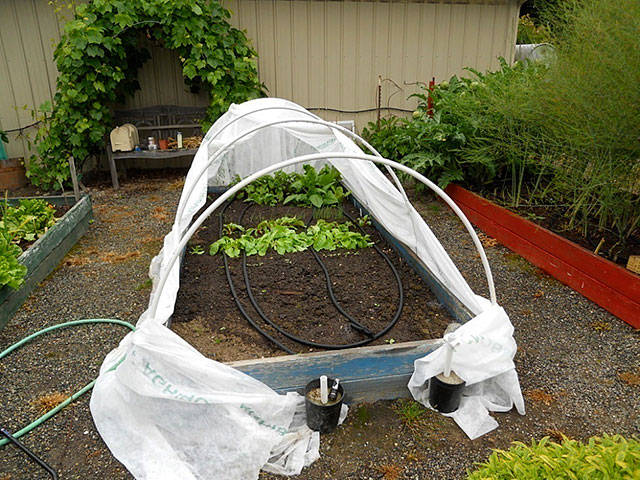It’s time to think about winter vegetables and how we can take care of these plants in the cold. Each vegetable has a minimum temperature for plant growth. For cool-season vegetables this is between 38-48 degrees. Below freezing, plant growth becomes compromised and tissue damage can occur.
The role (goal?) of season extending is to maintain plants in the growing temperature range and minimize damage below freezing. Season extending protects plants from the cold by creating mini-greenhouses.
The simplest way to do this is to remove the base from plastic milk jugs and place the jugs over individual plants that need protection. Remove the lids from the milk jugs during the day; close the lids on cold nights to protect plants from frost.
The next level of complexity and cost is to make low tunnels or cloches. These are made by forming PVC piping or wire into a hoop system over the vegetable bed. Polyethylene, row covers (Reemay or Agribon), or corrugated plastic sheeting is then placed over the hoops to form tunnels 10-16 inches high. This increases the daytime temperature around the plants by 8-13 degrees and keeps frost off crops at night.
Cold frames and hot beds are larger structures in which a wider range and size of winter crops can be grown. Construct a frame of lumber in a size that is easy to handle so they can be moved as needed. Make several so they can be stacked as the plants grow. The cover can be made from an old window or of clear plastic.
Alternatively, construct a rectangular box with straw bales or cinder blocks, covered with a transparent glass or plastic panel. Ideally, the north side of the box should be taller than the south side to increase the amount of light entering through the transparent cover.
Cold frames work by passive solar heating, while hot beds generate heat either from buried electrical heating cables or by heat given off by decomposing compost under the soil surface. Stacking gallon milk jugs filled with water around a cold frame or hot bed will allow the water to warm during the day and release heat at night.
Additional protection from freezing can be achieved by nailing insulation board to the interior of a cold frame or by covering it with an old blanket or rug.
Air circulation is critical in plant growth and disease prevention, so be prepared to ventilate the protected areas using an automatic vent or cover prop.
To prevent freezing as well as condensation of moisture on the leaves of the plant, do not allow leaves to touch the sides or top of the protective device.
Be on the watch for slugs and bugs, especially aphids. Like your plants, they appreciate these protected spaces.
Give your plants some heat and harvest all winter long.
Bob Cain is a WSU-certified Clallam County Master Gardener.


